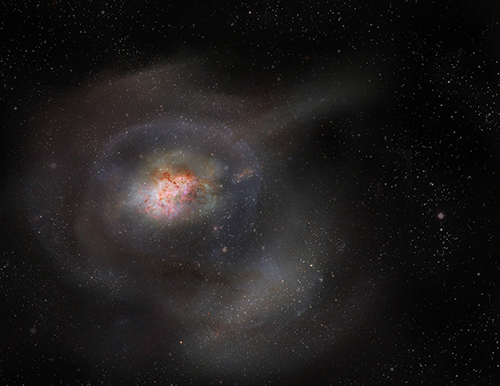A scientific research collaboration between an astronomer at The University of Toledo and one of his former undergraduate students who is now a postdoctoral researcher at the University of Washington resulted in a shocking discovery about galaxy evolution.
Dr. J.D. Smith, director of the UToledo Ritter Astrophysical Research Center and professor of astronomy, and UToledo alumnus Dr. Adam Smercina, who graduated with a bachelor’s degree in physics in 2015, worked with the National Radio Astronomy Observatory and a team of astronomers around the world to discover that post-starburst galaxies condense their gas rather than expelling it, begging the question: What’s actually keeping them from forming stars?

This artist’s impression highlights the compactness of molecular gas in a post-starburst galaxy and its lack of star formation.
Credit: ALMA (ESO/NAOJ/NRAO)/S. Dagnello (NRAO/AUI/NSF)
“It’s often the case that we as astronomers intuit the answers to our own questions ahead of observations, but this time, we learned something completely unexpected about the universe,” Smercina said.
Post-starburst galaxies are different from other galaxies. They also are born in the aftermath of violent collisions, or mergers between galaxies, which typically trigger massive bursts of star formation. But in post-starburst galaxies, this outburst slows down and near-completely stops almost as soon as it begins.
Beginning in 2012, Smercina, the lead author of the new study published in The Astrophysical Journal, worked with Smith as an undergraduate student at UToledo on the dust and gas in post-starburst galaxies. At the time, those galaxies were thought to scatter all of their gas and dust — the fuel required for creating new stars — in violent bursts of energy and with extraordinary speed, leaving little or no star-forming fuel in these galaxies’ central star-forming factories.
Now, new data from the Atacama Large Millimeter/submillimeter Array (ALMA) reveals that these galaxies don’t scatter all of their star-forming fuel after all. Instead, after their supposed end, these dormant galaxies hold onto and compress large amounts of highly concentrated, turbulent gas. But contrary to expectation, they’re not using it to form stars.
“There is much about the evolution of a typical galaxy we don’t understand, and the transition from their vibrant star-forming lives into quiescence is one of the least-understood periods,” said Smith, a co-author of the study. “Although post-starbursts were very common in the early universe, today, they are quite rare. This means the nearest examples are still hundreds of millions of light-years away, but these events foreshadow the potential outcome of a collision, or merger, between the Milky Way Galaxy and the Andromeda Galaxy several billion years from now. Only with the incredible resolving power of ALMA could we peer deep into the molecular reservoirs left behind ‘after the fall.’ ”
Smercina was honored in 2015 by the UToledo College of Natural Sciences and Mathematics as an outstanding undergraduate for his work with Smith, a collaboration that has continued cross country.

From left, Dr. Decker French, assistant professor of astronomy at the University of Illinois Urbana-Champaign, Dr. Adam Smercina, a postdoctoral researcher at the University of Washington, and Dr. J.D. Smith, director of the UToledo Ritter Astrophysical Research Center and professor of astronomy. The photo was taken at the Aspen Center for Physics meeting in February 2020.
“We’ve known for some time that large amounts of molecular gas remain in the vicinity of post-starburst galaxies but haven’t been able to say where, which in turn, has prevented us from understanding why these galaxies stopped forming stars. Now, we have discovered a considerable amount of remaining gas within the galaxies and that remaining gas is very compact,” Smercina said. “While this compact gas should be forming stars efficiently, it isn’t. In fact, it is less than 10% as efficient as similarly compact gas is expected to be.”
In addition to being compact enough to make stars, the gas in the observed dormant — or quiescent—galaxies had another surprise in store for the team: It was often centrally located, though not always, and was surprisingly turbulent. Combined, these two characteristics led to more questions than answers for researchers.
“The rates of star formation in the post-starburst galaxies we observed are much lower than in other galaxies, even though there appears to be plenty of fuel to sustain the process,” Smercina said. “In this case, star formation may be suppressed due to turbulence in the gas, much like a strong wind can suppress a fire. However, star formation can also be enhanced by turbulence, just like wind can fan flames, so understanding what is generating this turbulent energy, and how exactly it is contributing to dormancy, is a remaining question of this work.”
The discovery of turbulent, compact gas in otherwise dormant galaxies gives researchers one more clue to solving the mystery of how galaxies, in particular, live, evolve and die over the course of billions of years.
Read the full study, titled “After the Fall: Resolving the Molecular Gas in Post-starburst Galaxies,” on The Astrophysical Journal website.